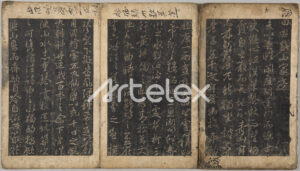Kim Saeng (711 – unknown) was a famous calligrapher of the Silla period during the North-South States era.
When Goryeo’s envoy Hong Gwan presented Kim Saeng’s calligraphy in the Song dynasty, the people of Song praised it highly, comparing him to the Chinese calligraphy master Wang Xizhi. Although none of Kim Saeng’s original works remain, inscriptions and plaques such as the “Ichadon Stele” and the “Baekryeon Temple Plaque” are attributed to him.
The “Jeonyuam Sanga Seo” (田遊巖山家序) is a calligraphy work by Kim Saeng from the Unified Silla period.
This piece describes a tranquil life in the mountains at Jeonyuam and reflects Kim Saeng’s philosophy and love for nature. Comprising a total of 315 characters, this work showcases Kim Saeng’s exquisite small regular script and semi-cursive script.
This piece holds significant importance in Korean calligraphy history, demonstrating Kim Saeng’s artistic achievements and the integration of Chinese and Korean calligraphic techniques.
These elements illustrate the cultural and artistic influence Kim Saeng had on Korean calligraphy, highlighting his role in shaping the unique Korean style while being influenced by Chinese methods.

